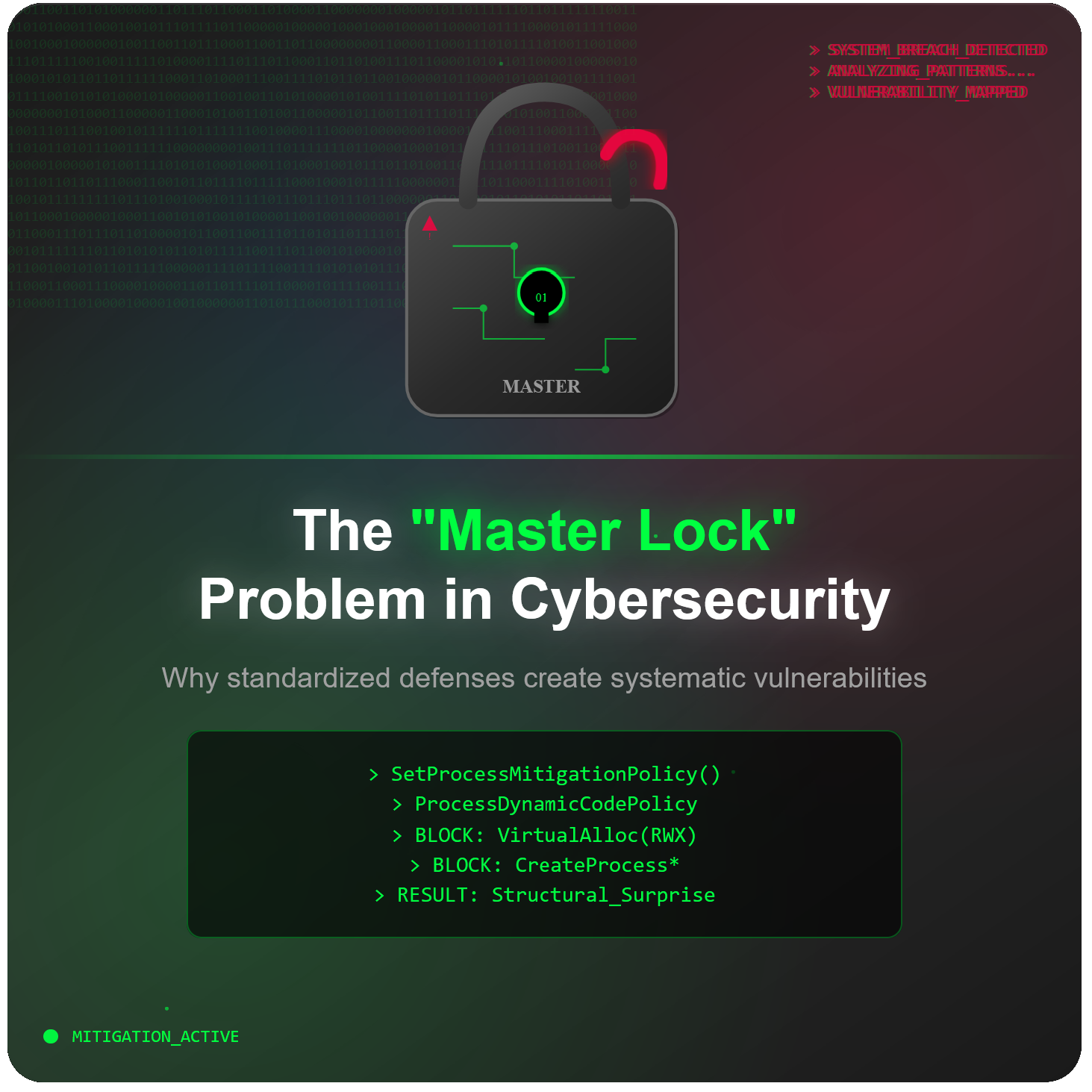
Karma-X Blog
The “Master Lock” Problem

How hard is it to pick a Master Lock? What does this say about cybersecurity?
Every door with the same Master Lock? Convenient for users, perfect for thieves. When everyone uses identical defenses, attackers solve the puzzle once and scale everywhere. This is cybersecurity's homogeneity problem.
Popular Master Locks are everywhere and "good enough"—but locksmiths can pick them in seconds. In cybersecurity, the same dynamic emerges when platforms standardize controls across millions of endpoints.
Enterprise security platforms optimize for deployment scale, creating dangerous uniformity across memory layouts, API hooks, detection signatures, and process instrumentation. This standardization provides attackers with a consistent attack surface—they can purchase the same EDR/XDR stack, reverse-engineer its userland hooks, identify blind spots in its kernel callbacks, and develop bypasses that scale across thousands of endpoints.
When 60% of enterprises run identical security stacks, a single bypass technique (API unhooking, direct syscalls, or signature evasion) compromises millions of systems simultaneously. The attacker's R&D investment has massive leverage.
Standardized security platforms create predictable chokepoints:
Public detection rules become reverse-engineering guides. YARA signatures, Sigma rules, and published IoCs tell attackers exactly which bytes, registry keys, and network patterns to avoid. Every public rule is a constraint that can be optimized around.
Example: A YARA rule matching { 48 89 E5 ?? ?? ?? ?? E8 } (x64 function prologue pattern) can be defeated by inserting a single NOP instruction or using alternative calling conventions. Static analysis becomes a game of byte-level optimization rather than functional prevention.
Rather than detecting malicious behavior post-execution, protection-first systems enforce structural invariants that make entire exploit classes impossible:
Protection > Detection
Modify system semantics so exploitation primitives fail at the kernel/hardware level, independent of payload novelty.
"Surprise" techniques violate attacker assumptions about OS behavior by intercepting and denying operations that exploitation chains depend on. Implementation approaches:
Technical goal: Transform exploitation from "run arbitrary code" to "specific system call sequence must succeed," dramatically increasing attacker workload.
Windows provides kernel-enforced mitigations via SetProcessMitigationPolicy. These operate at the memory manager and loader level, creating structural barriers that break exploitation primitives:
// Compile with: cl /W3 /D_WIN32_WINNT=0x0602 surprise.c
#include <windows.h>
#include <processthreadsapi.h>
#include <stdio.h>
/*
* Technical Mitigation Analysis:
* Each policy modifies kernel behavior to deny specific operations
* that exploit chains depend on. Applied before process initialization
* for maximum coverage.
*/
int enable_technical_mitigations(void) {
// 1. ARBITRARY CODE GUARD (ACG) - ProcessDynamicCodePolicy
// Kernel enforcement: Memory manager denies RWX transitions
// Blocks: VirtualAlloc(PAGE_EXECUTE_READWRITE), VirtualProtect(PAGE_EXECUTE)
// Technical effect: Prevents shellcode allocation and JIT compilation
PROCESS_MITIGATION_DYNAMIC_CODE_POLICY dynCode = {0};
dynCode.ProhibitDynamicCode = 1; // Deny dynamic code creation
dynCode.AllowThreadOptOut = 0; // No thread-level bypass
// 2. BINARY SIGNATURE POLICY - ProcessSignaturePolicy
// Loader enforcement: Image verifier checks PE signatures during LoadImage
// Blocks: LoadLibrary() on unsigned DLLs, reflective DLL injection
// Technical effect: Only Microsoft-signed code can be loaded
PROCESS_MITIGATION_BINARY_SIGNATURE_POLICY sigPolicy = {0};
sigPolicy.MicrosoftSignedOnly = 1; // Require MS signature
sigPolicy.AuditMicrosoftSignedOnly = 0; // Enforce, don't just audit
// 3. IMAGE LOAD POLICY - ProcessImageLoadPolicy
// Loader enforcement: Path validation during PE load operations
// Blocks: UNC path loads, low integrity image loads, non-system32 preference
// Technical effect: Restricts DLL search path exploitation
PROCESS_MITIGATION_IMAGE_LOAD_POLICY loadPolicy = {0};
loadPolicy.NoRemoteImages = 1; // Block \\server\share\evil.dll
loadPolicy.NoLowMandatoryLabelImages = 1; // Block low integrity loads
loadPolicy.PreferSystem32Images = 1; // Prefer system32 over current dir
// 4. CHILD PROCESS POLICY - ProcessChildProcessPolicy
// Process manager enforcement: Denies CreateProcess* family calls
// Blocks: Living-off-the-land binaries, payload staging, lateral movement
// Technical effect: No subprocess creation regardless of privileges
PROCESS_MITIGATION_CHILD_PROCESS_POLICY childPolicy = {0};
childPolicy.NoChildProcessCreation = 1; // Block CreateProcess*
childPolicy.AuditNoChildProcessCreation = 0; // Enforce immediately
// Apply policies - must succeed before process loads additional images
BOOL result = TRUE;
result &= SetProcessMitigationPolicy(ProcessDynamicCodePolicy, &dynCode, sizeof(dynCode));
result &= SetProcessMitigationPolicy(ProcessSignaturePolicy, &sigPolicy, sizeof(sigPolicy));
result &= SetProcessMitigationPolicy(ProcessImageLoadPolicy, &loadPolicy, sizeof(loadPolicy));
result &= SetProcessMitigationPolicy(ProcessChildProcessPolicy, &childPolicy, sizeof(childPolicy));
return result;
}
int main(void) {
printf("=== Process Mitigation Policy Implementation ===\n");
printf("Applying kernel-level exploit mitigations...\n");
if (!enable_technical_mitigations()) {
printf("ERROR: Failed to apply mitigations (error: %lu)\n", GetLastError());
return 1;
}
printf("SUCCESS: All mitigation policies applied\n");
test_blocked_operations();
return 0;
}Arbitrary Code Guard (ACG) modifies the Windows memory manager to deny VirtualAlloc(PAGE_EXECUTE_READWRITE) and VirtualProtect calls that would create or modify executable pages. This breaks:
Binary Signature Policy intercepts LoadLibrary and LdrLoadDll calls in the NT loader, validating Authenticode signatures against Microsoft's certificate chain. This prevents:
Homogeneous defenses create economies of scale for attackers—one bypass technique (like direct syscalls to avoid userland hooks) works across thousands of identically-configured endpoints. Diverse, structural controls force attackers into diseconomies of scale—each target requires custom reconnaissance and exploitation.
Protection-first eliminates the critical time-to-detection gap. Traditional detect-and-respond models have inherent latency:
This shifts security outcomes from "contained breach" to "failed attack attempt" at the system call level.
Explore related Windows security features:
From small business to enterprise, Karma-X installs simply and immediately adds peace of mind
Karma-X doesn't interfere with other software, only malware and exploits, due to its unique design.
Whether adversary nation or criminal actors, Karma-X significantly reduces exploitation risk of any organization
Update to deploy new defensive techniques to suit your organization's needs as they are offered